
Portable Surgical Kits Page Menu: 1 2 3 4 5 6 7 8 9 <<First
Portable Surgical Kits From the Golden Age of Piracy, Page 9
Salvatory
“For Reputation the Trojan and Grecian Princes have added to it [the surgeon’s practice], who we are told, understood Surgery; and never went to their Wars without a Box of Salves.” (John Atkins, "The Preface", The Sea Surgeon, 1742, not paginated)
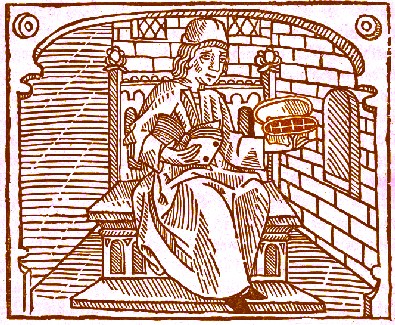
Artist: Jacobus de Cessolis
Physician/Apothecary Holding a Salvatory Box, Wellcome Collection (1483)
If sea surgeon Atkins is to be believed, the salvatory, or box of salves, dates to antiquity. Surgeons during the golden age of piracy called the salvatory by various names including the simple 'box of salves'1, salve box2, salbatory3, box of unguents4, and even dressing box5. However, the most common name given it seems to have been salvatory.6 Historians Nancy Cox and Karin Dannehl say that the earliest use of the term salvatory is 1549, well before the golden age of piracy.7
In his book, French surgeon Charles Gabriel Le Clerc explained that the salvatory was considered a portable 'instrument', "because the Balsams, Ointments, and Plaisters contain'd therein, are means whereof the Surgeon makes use to restore Health."8 It was clearly a portable case on a ship, because sea surgeon John Moyle told his readers that this box was to be brought to mast every day for treatment of the men.9
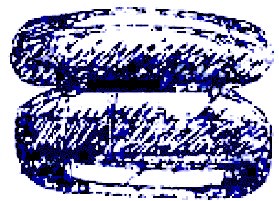
Salvatory Box, Randle Holme (1688)
The box itself was made from a variety of different materials. Encyclopedist Randle Holme says the salvatory is "a Box with a Lid made generally of Latin [this could be either black latten - a copper alloy, or white latten - a tin-plated lead] or Tin, some more Rich have them Silver, but that is for shew, more than good Profit"10. Holme includes an image of his box (seen at left), although it is very hard to make out any detail from that. It is clearly rounded on the ends and there is some evidence of partitions inside the open box.
William Fabry completely disagreed with Holme regarding material. He says that the salvatory "ought to be
made of Horn, or some solid wood, as
Ebony, Guaiacum, or Box [Buxus sempervirens - evergreen wood], for Unguents are better preserved in wood, than in Silver, Copper, &c."11 English military surgeon James Cook repeats this assertion, which suggests he agrees with it, although he makes no actual comment regarding its
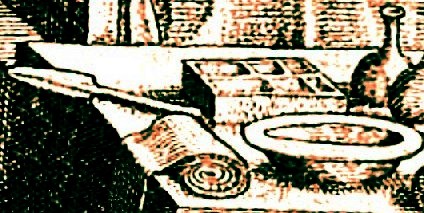
Salvatory, Spatula, Roller Bandage, Basin and Bottles, Friom Opera Quae
Extant Omnia,
By William Fabry, Wellcome Collection (1646)
validity.12 An image of Fabry's salvatory can be found below right along with some bottles, a roller bandage and basin and a spatula. Unlike the salvatory mentioned by Holme, this box is square and contains irregularly-sized compartments.
Several period authors note that the salvatory is partitioned. Most of the surgeons during this period mention at least six partitions. For example, William Fabry says that salvatory has 'six divisions'13, while sea surgeon John Woodall advises "if it containe vj. [6] several unguents it is sufficient for any present use"14, implying that the salvatory would need six divisions. Randle Holme expands upon the idea, explaining that "it hath six or more several divisions in it, which are furnished with so many several Unguents, which though each hold but a small quantity, yet it is sufficient for present use"15. Holme lists eight unguents in his description without suggesting there would be room for less in the box.
John Moyle deviates slightly from the crowd, advising that the salvatory "6 or 8 Partitions in it, and a Place for Plaisters ready spread."16
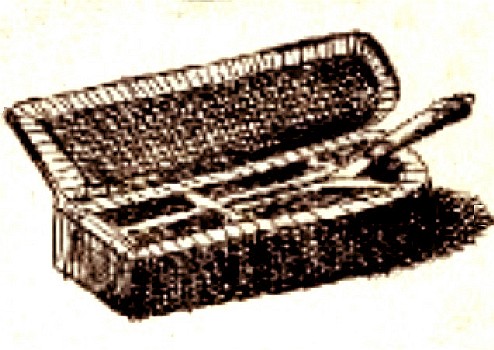
Artist: Marcellus Laroon - Salvatory & Spatula, From Mounabanck image (1688)
It is interesting that Moyle puts the plasters in the salvatory; he only mentions pocket instruments (and, by implication, a pocket kit) in his book, not a plaster box. He is the author under study who combines the function of the plaster drawer (usually found in the plaster box) with the salvatory. Since both are medicinal, this is actually pretty logical.
The size of salvatories are not discussed by any of the period authors, nor is there an example of one from the period to measure. However, from the images where the box is shown relative to other surgical tools, tables and people suggest they would have been about six to nine inches long by about two to six inches wide and about one and a half to three inches deep. (The size is obviously dependent on the style of box. There is a great deal of variance between the types of these boxes as the images show.) Since this box was portable, it was most likely to have been made to fit in the surgeon's waistcoat pocket. Nine inches would be about the maximum length and three or four inches the maximum width it could be if it were to fit in such a pocket.
As for the use of the box, William Fabry states that "a Chirurgeon ought always to have about him" his salvatory box.17 Sea surgeon Moyle gives the clearest definition of its use. "In the Partitions you put your Pots and Glasses of Balsams and Oyles for present use."18 He adds that "this Box as well as your pocket Instruments must be carried every Morning to the Mast between Decks, where our Mortar is usually rung, that such as have any Sore or Ailment may hear in any part of the Ship, and come thither to be drest."19
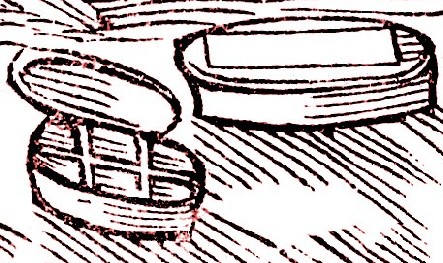 Salvatory and Pocket Kit/Plaster Box, From A profitable and Necessarie Booke of Observations, By William Clowes, p. 140 (1596) |
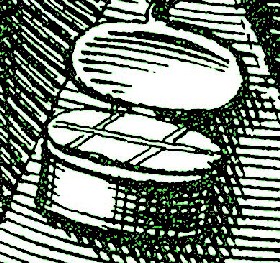 Salvatory, From Habit de Chirurgion, By Nicolas de Larmessin (1695) |
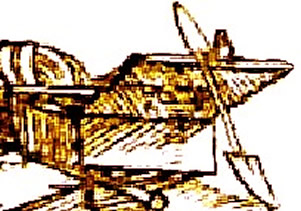 Salvatory and Spatule From Opus Chyrurgicum, By Paracelsus, p. 67 (1565) |
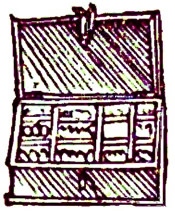 Salvatory Style Box, Wundartzney, By J. Charetanus (1531) |
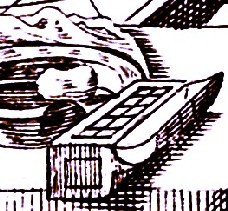 Artist: Wolfgang Killian Salvatory, Wellcome Collection (1652) |
1John Atkins, "The Preface", The Sea Surgeon, 1742, not paginated; 2 Nancy Cox and Karin Dannehl, "Dictionary of Traded Goods and Commodities 1550-1820," british-history.ac.uk, gathered 11/15/16; 3,4 Randle Holme, The academy of armory, Book III, 1688, p. 438; 5 John Moyle, Chirugius Marinus: Or, The Sea Chirurgeon, 1693, p. 46. This sounds like the plaster box, but based on Moyle's description it is the salvatory; 6 See for example Guliielm. Fabritius Hildanus aka. William Fabry. Cista Militaris, Or, A Military Chest, Furnished Either for Sea or Land, 1676, p. 23, Thomas Brugis, Vade Mecum, 1689, p. 2, James Cooke, Supplementum chirurgiae and the Military Chest, 1655, p. 423 & John Woodall, the surgions mate, 1617, p. 24, among others; 7 Cox and Dannehl, ibid; 8 Charles Gabriel Le Clerc, The Compleat Surgeon, 1701, p. 6; 9 Moyle. p. 46; 10 Holme, p. 438; 11 Fabry. p. 24; 12 James Cooke, Supplementum chirurgiae and the Military Chest, 1655, p. 424; 13 Fabry. p. 24; 14 Woodall, p. 24; 16 Holme, p. 438; 16 Moyle. p. 46; 17 Fabry. p. 23; 18,19 Moyle. p. 46
Salvatory Unguents
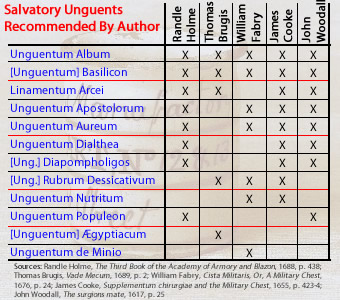
Just as the surgical authors had a variety of opinions on which instruments and plasters to include in plaster boxes and pocket kits, so they had differing ideas on which unguents should be carried in the salvatory for medical emergencies. Five of the authors under study recommended salves which resulted in twelve medicines, all unguents or unguent-like medicines, being suggested for the salvatory.
The resulting medicinal recommendations can be seen in the chart at right. The author recommending the medicines are listed across the top (in no particular order) with the unguents being listed along the side (in order of their popularity). Like the previous charts, red lines separate a change in number of authors supporting the salves, beginning with the two that are recommended by all five authors and ending with two medicines which are only mentioned by a single author.

James Cooke
Most of the authors list seven to nine unguents with the exception being Thomas Brugis, who only lists five. (He sort of lists six, but one of them is Ægyptiacum mixed with Basilicon, each of which he also lists individually.1)
Randle Holme apparently favors a salvatory with eight compartments since he simply lists eight unguents without suggesting any could be left out.2 The rest of the authors suggest six medicines with some others being mentioned as alternates. William Fabry's list contains six medicines with the seventh, unguentum de minio, being included as an alternate to Dessicativum Rubrum.3 Military surgeon James Cooke also suggests alternate medicines, suggesting that either linamentum arcei or unguentum nutritum can be used in place of unguentum album.4
Two of the authors specifically discuss medicines which can be added when there are eight compartments in the salvatory instead of only six. Based on the way these other two medicines are mentioned, they would appear not to be as necessary as the first six. Woodall explains that "if the Savlatorie have eight roomes, then two more [salves] as necessarie as the former [six] may be added, as namely unguentum Populeon, and unguentum Album"5. Cooke similarly suggest that "if there be eight rooms, then [Unguentum] dialthea, and Diapompholigus may be used"6.
1 Thomas Brugis, Vade Mecum, 1689, p. 2; 2 Randle Holme, The academy of armory, Book III, 1688, p. 438; 3 Guliielm. Fabritius Hildanus aka. William Fabry. Cista Militaris, Or, A Military Chest, Furnished Either for Sea or Land, 1676, p. 23-4, 4 James Cooke, Supplementum chirurgiae and the Military Chest, 1655, p. 424; 5 John Woodall, the surgions mate, 1617, p. 25; 6 James Cooke, Supplementum chirurgiae and the Military Chest, 1655, p. 424; 5 Cooke, p. 424
Salvatory Unguent Descriptions
Twelve unguents and salves suggested by the period authors for inclusion in the salvatory. Three of the authors saw fit to provide descriptions of how the medicines they recommended were to be
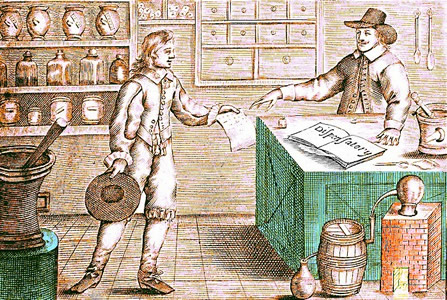
From The Expert Doctor's Dispensatory, By Pierre Morel, Wellcome Collection (1657)
used including military surgeon Thomas Brugis, sea surgeon John Woodall and French surgeon Charles Gabriel Le Clerc. These descriptions will be used to explain the purpose of each unguent, along with some other information where their descriptions are not complete.
Ten of these medicines are found in the Sea Surgeon's Dispensatory article which lists all the medicines mentioned by sea surgeons from this time period. This attests to the usefulness of these unguents in first aid situations. (Sea surgeons often dealt with triage situations where immediate treatment of simple wounds, fractures, burns and similar wounds was required.) Each medicine that can be found in the Dispensatory is linked to its entry for those seeking more information including alternate names for the medicine, which sea surgeons recommended them, their humoral properties, and details about composition. For the two medicines which are not found in the Sea Surgeon's Dispensatory article, they appear in the same format as is used in that article including the name listed in bold, red text, alternate medicine names shown, humoral properties, the prescription, and the description of how it was used.
The medicines are listed here in the same order that they appear in the "Salvatory Unguents Recommended By Each Author" chart found in the previous section.
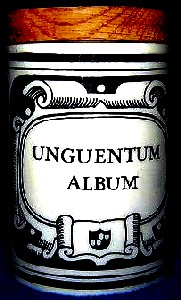
Unguentum Album
1. Unguentum Album - "This Ointment is good for Burns, Erysipelas's [St. Anthony's Fire, an acute skin infection], the Itch, and many Distempers of the Skin; it allayes the Itchings and intemperature of Ulcers; it dissipates the Chafings and Redness that happen in the Bodies of Infants; It is of great efficacy in the healing of Contusions [bruises], and it serves to consolidate and cool light Wounds."1 Note that Le Clerc and Brugis both add camphor to this unguent, which may account for its usefulness in burns and other skin problems. Le Clerc also adds white lead (ceruse), said to have a drying faculty.
2. [Unguentum] Basilicon - "Basilicon is an Unguent used almost in all kinds of Wounds, and Ulcers, either by its self, or mixed with other Unguents; for it hath the virtue to heat, humect [moisten], and mitigate pain: it digesteth [breaks down] and incarnateth [encourages the growth of flesh in] Wounds and Ulcers, and suppurateth [causes pus to form and be ejected] Apostemes, either hot or cold. It is likewise very fitly used with [mercury] Præcipitate, Ægyptiacum, or any corroding Medicine, making them work with more ease, and better mundifies [cleanses]: it is also good for Burnings and Scaldings"2.
3. Unguentum/Linamentum Arcei - "This Aræcus’s Liniment in is a sovereign [supreme or ultimate] Balm, not to be sufficiently commended in all Wounds whatsoever, especially in those of the Head, where it doth merely of it self, all the intentions of healing, extraneous Bodies being first remov’d, and the Flux of Bloud quite stay’d [stopped], for it digesteth, mundifieth, incarnateth, and cicatrizeth [heals with a scar], it defendeth from accidents [complications such as infection] and is very anodine [soothing or able to remove pain]: I have divers times applied it, mixed with other Unguents, to painful Ulcers, and Fistula’s, with good success"3.
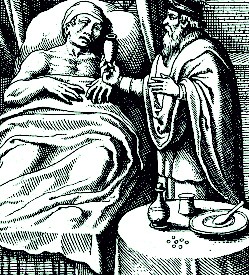
From De Efficaci Medicina Libri Tres, By
Marco Aurelio Severino (1646)
4. Unguentum Apostolorum - "This unguent serveth well to cleanse and scowre ulcers and fistula's, and to make a good ground to healing: it is of temperament hot and dry: it was devised by Avicen[na - a 10th/11th century Persian physician and scholar]; named Apostolorum, for that it consisteth of twelve several ingredients joyned into one body."4
5. Unguentum Aureum - "This unguent serveth well to incarn [heal by filling with flesh] wounds and ulcers, being first well mundified [cleansed]: it is also to be used as a balm to them to heal them, and is a good healer of burnings and scaldings, the fire first taken out."5 Physician and apothecary Nicholas Culpeper gives a slightly different explanation. "It consumes corrupt and dead flesh [meaning it works as a potential cautery], and makes flesh soft which is hard; it cleanseth Wounds, Ulcers and Fistulaes, and restores flesh where it is wanting."6
6. Unguentum Dialthea - "This Ointment serves to moisten, mollifie [reduce pain], and heat gently; it also allayes the Pains of the Side, and softens Tumours, particularly the Parotides [an inflammation of the salvatory glands on either side of the face]. It may be us'd either alone, or with other Ointments or Oils."7
7. [Unguentum] Diapompholigos - Woodall states that this heals painful ulcers anywhere in the body but "especially of the yard [penis], or betwixt glans and preputium" which would accompany venereal diseases. He praises it as being better than "all other Unguents in ulcers of the yard, against virulent, painfull, and corrosive ulcers scarse a better composition is knowne; in Nolime tangere [A cancerous ulcer that eats away bone and soft tissue] in the face I have had good experience of it: and in many other occasions I have found it a very good Unguent"8.
8. Unguentum Rubrum Dessicativum (also called 'Dessicativum Rubrum' and 'red drying ointment')
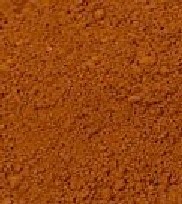
Armenian Bole
Humoral Property: Drying
Rx: "Oyl of unripe Olives {1 pound} white Wax {5 ounces} Terra-Lemnia or Bole armeniak, Lapis Calimaris, of each {4 ounces}. Lithargie of Gold, Ceruse, of each {3 ounces} Camphyr {1 dram} make it into an Unguent according to Art."9
Description: "This topical Medicament, which is most usual and successful is from its effect called Desiccative [drying]; from its colour, Red. ...It refrigerates [cools], roborates [strengthens], stayes fluxions [flows of humors], defends parts effected, digests, absumes [gradually consumes], and siccates [dries] excrementitious humidity, and heals Ulcers and Wounds."109. Unguentum Nutritum - Woodall uses this lotion to cure skin infections accompanied by a rash, abrasions, burns and
_Francis_Hayman_mid_18th.jpg)
Artist: After Francis Hayman (mid 18th c.)
scalds, scabs of the skin, itching and shingles. He also suggests it "for any moist humour flowing to any ulcers in any part of the body, being spread upon cap-paper thin, and laid over the whole distempered part ...[and] it is an especial good defensative against any scalding or vicious humour, flowing to any ulcer."11
10. Unguentum Populeon - Woodall says that this unguent relieves pain in the joints caused by Scurvy. It can similarly be rubbed on the temples to give patients with fevers rest as well as to assuage pain in any part of the body. Woodall praises it as being "exceeding comfortable and behovefull, that scarse any composition of an Unguent in the Surgions Chest may compare with it"12. He also notes that it can be used to relieve the pain caused after using potential cautery to burn away unwanted skin.
11. [Unguentum] Ægyptiacum - Thomas Brugis says that Ægyptiacum cleans and soothes "old, sordid, virulent and fistulous [riddled with hollow sections] Ulcers" and is good for preventing gangrene in wounds.13 Woodall explains that it is "best to be put into the grief scalding hot" implying that it works faster to relieve the pain in that way. He recommends it be used in venomous wounds, large bruises and ulcers of the mouth, particularly those caused by scruvy.14
12. Unguentum de Minio (Also called Unguentum de Minio Camporatum, Unguentum de Litharge or Camporated Ointment of red lead)
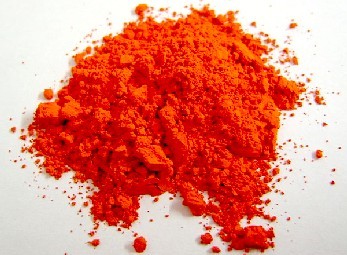
Photo: Wiki User BXXD - Red Lead Oxide
Humoral Properties: Drying and Cooling15
Rx: "Take of Oil of Roses {1.5 pounds} of red Lead {3 ounces} of Litharge {2 ounces} or Ceruss {1.5 ounces} of tutty {3 drams} of Camphire {2 drams} of Wax {1.5 ounces}. Make them into an Ointment with a Leaden Mortar and Pestle; the Wax first being melted with a gentle Fire, and the rest being added in fine Powder."16
Description: "[I]t conduces to ill and inveterate Ulcers, which scarce admit of internal curation, and purduces [brings] them to scars."17 Physician Nicholas Culpeper says that he believes "it seldom fails" when applied to "sores, and such as are troubled with Defluxions [flows from the wound]", although he also warns that a physician tried to use it on his mother's breast cancer "but to as much pupose [sic] as if he had a applied a rotten Apple"18.
1 Charles Gabriel Le Clerc, The Compleat Surgeon, 1701, p. 372; 2 Thomas Brugis, Vade Mecum, 1689, p. 12; 3 Brugis, p. 12; 4,5 John Woodall, the surgions mate, 1655, p. 31; 6 Nicholas Culpeper, Pharmacopœia Londinesis, 1720, p. 231; 7 Le Clerc, p. 370; 8 Woodall, the surgions mate, 1617, p, 45-6; 9 Jean de Renou, A Medicinal Dispensatory, 1657, p. 694; 10 Renou, p 695; 11 Woodall, 1617, o, 46-7; 12 Woodall, 1617, o, 47; 13 Brugis, p. 13; 14 Woodall, 1617, o, 45; 15 Culpeper, p. 226; 16John Quincy, Pharmacopoeia Officinalis & Extemporanea, 1719, p. 503; 17 Renou, p 697; 18 Culpeper, p. 226

